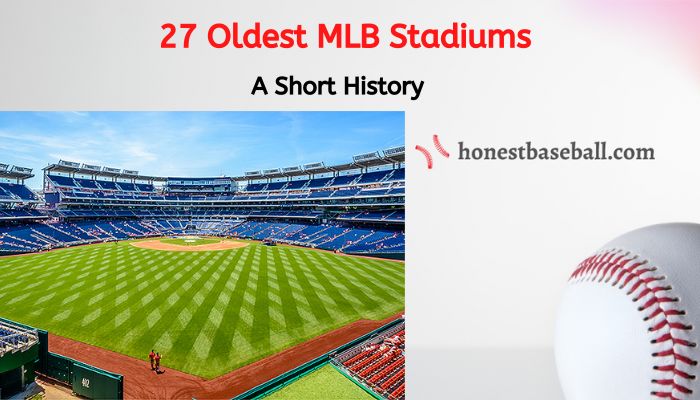There are no varieties in stadium construction like baseball stadiums. Baseball ballparks or specifically the oldest MLB Stadiums are always something special to discuss.
Major League Baseball is one of the oldest leagues that has many histories. Stadiums that are and have been associated with it also have historical appeal. Some of them are on the US National Register of Historic Places.
However, what are the oldest MLB stadiums, you know? Here I will be talking from the 27 oldest baseball stadiums to the newest baseball parks used in Major League baseball.
Let’s dive into history.
List of 27 Oldest Baseball Stadiums
1. Fenway Park – 1912
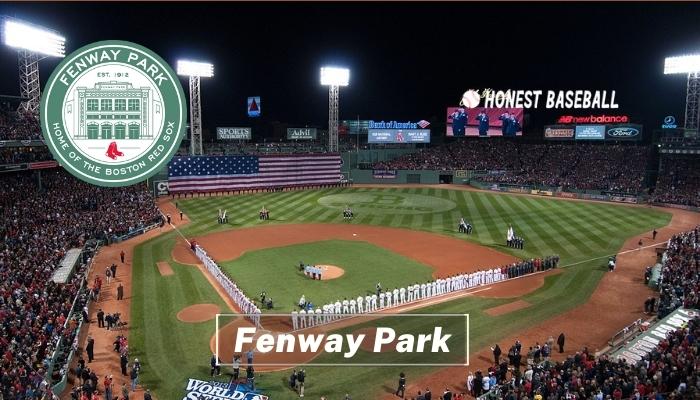
- Situated in: Boston
- Host Team: Boston Red Sox
- First Opened: 20th April 1912
- The capacity of Spectators: latest official capacity is 37,673 for night games and 37,227 for day games. (Fenway’s capacity fluctuates slightly due to renovations and seating changes).
- The Player Who Got the First Home Run: Hugh Bradley (26th April 1912)
- The Player Who Leads the Home Run for All-Time: Ted Williams (248)
The home ground of the Boston Red Sox has been proudly standing as the oldest baseball stadium in the USA since 1912 still in use. It was opened just a few days after the legendary Titanic was sunk.
Before this, Red Sox played on Huntington Avenue Ground from 1901 to 1911.
Originally created by architect John N. Hoyt, the park sits atop a landfill in Boston’s Fenway-Kenmore area. 10,000 fans watched the park’s debut game against the New York Yankees on April 20, 1912.
Did you know the lone red seat in Fenway (Section 42, Row 37, Seat 21) marks the longest home run ever hit in the stadium? (502 feet by Ted Williams in 1946).
One of America’s most recognizable landmarks, Fenway Park is a baseball mecca.
Well-known features include the Green Monster wall in left field and the unusual seating design, which requires fans to climb stairs to reach some sections of the stadium. Just over 37,000 spectators can fit inside the stadium, making it Major League Baseball’s oldest venue.
The significance of Fenway Park is its 37-ft Green Monster left wall. Aside from this, the manual scoreboard and the Pesky Pole are in the right field. In 1934, the Fenway Park Authority brought some innovative changes to it.
In 2001, the Green Monster was altered. As a result, the stadium’s capacity was increased by 4000 seats. By the way, Fenway Park is also the minor ballpark in MLB, along with its oldest construction.
One of the achievements of Fenway Park is it hosted 11 World Series. Among them, Boston Red Sox won 6.
2. Wrigley Field – 1914
Wrigley Field. The Friendly Confines. A cathedral of baseball. More than just a ballpark, it’s a living, breathing piece of Americana, woven into the fabric of Chicago and the heart of baseball itself. Opened on April 23, 1914, this iconic stadium, home to the Chicago Cubs, has witnessed over a century of baseball history, from legendary players to unforgettable moments, making it a cherished landmark for fans across the globe.
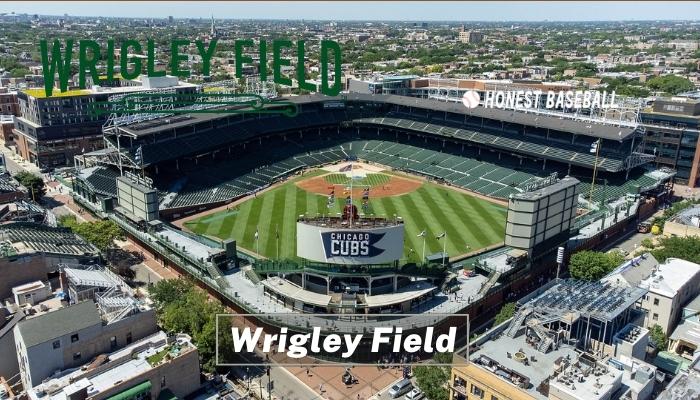
- Situated in: Chicago
- Host Team: Chicago Cubs
- First Opened: 23rd April 1914
- The capacity of Spectators: 41,649
- The Player Who Got the First Home Run: Art Wilson
- The Player Who Leads the Home Run for All-Time: Sammy Sosa (293)
The same year, Wrigley Field also hanged its first-ever World Series championship flag.
The name was changed to Wrigley Field because William Wrigley Jr. became the owner of most of the share of the ballpark by that time.
One of Wrigley’s most distinctive features, and a defining part of its charm, is the ivy-covered outfield walls. These aren’t just for show; they’re a part of the game. Since 1934, the Boston ivy has wrapped its way around the brick, creating a unique and sometimes challenging playing surface. Balls can get lost in the thick foliage, turning routine fly balls into unexpected outs or even inside-the-park home runs. The ivy has also become a symbol of Wrigley Field, adding to its mystique and earning it the affectionate nickname “The Friendly Confines.” This nickname, though its exact origin is debated, perfectly captures the welcoming and intimate atmosphere of the park.

Wrigley Field has hosted countless memorable games, from crucial World Series matchups to dramatic walk-off home runs. While Sammy Sosa holds the all-time home run record at Wrigley with 293 blasts, the stadium has been the stage for so much more. Home runs are exciting, but it’s the collection of moments, the shared experiences, and the unique atmosphere that truly define Wrigley.
However, Wrigley field moved into the ballpark in 1916. Since 1988, it has been the last ballpark that has installed lights for night games. The USA historic landmark authority added this as a National Historic Landmark in 2020.
Balancing preservation with progress is an ongoing challenge at Wrigley Field. While modern amenities have been added to enhance the fan experience, great care has been taken to maintain the stadium’s historical integrity. The goal is to ensure that Wrigley Field remains a cherished landmark for generations to come, a place where the echoes of the past mingle with the excitement of the present.
Do you know, why is the American flag backward on baseball uniforms? You might check on the detailed guide.
3. Dodger Stadium – 1962

- Situated in: Los Angeles
- Host Team: Los Angeles Dodgers
- First Opened: 1oth April 1962
- The capacity of Spectators: 56,000
- The Player Who Got the First Home Run: Wally Post
- The Player Who Leads the Home Run for All-Time: Eric Karros (130)
One of the three stadiums during MLB’s 1950s–1960s west coast expansion that is still in use is the Dodger Stadium. It has never risen beyond the approximately 56,000 capacity it had at its founding. It is the third oldest baseball field currently in use.
The story of Dodger Stadium begins with the team’s departure from Brooklyn in 1958. After years of unsuccessful attempts to build a new stadium in New York, O’Malley made the bold decision to relocate the Dodgers to Los Angeles. The move proved to be a turning point in baseball history, ushering in a new era of westward expansion for the sport.
The Dodger Stadium broke the all-time attendance record to 27,55,184 in 1977 after Cleveland had done this since 1948. Cleveland’s record has been 26,20,627 visitors since then. And Dodger Stadium held the record in 1977, 1978, and 1982.
Over the years, Dodger Stadium has witnessed countless memorable moments, from Sandy Koufax’s perfect game in 1965 to Kirk Gibson’s dramatic home run in the 1988 World Series. The stadium has hosted 10 World Series, and the Dodgers have claimed five championships within its walls.
Dodger Stadium holds a special place in baseball history. It’s a testament to the vision of its creators, a symbol of the Dodgers’ success in Los Angeles, and a beloved landmark for fans around the world.
4. Angel Stadium of Anaheim – 1966
- Situated in: Anaheim, Calif
- Host Team: Los Angeles Angel
- First Opened: 19th April 1966
- The capacity of Spectators: 45,517
- The Player Who Got the First Home Run: Rick Reichardt
- The Player Who Leads the Home Run for All-Time: Tim Salmon (160)
Since 1966, Los Angeles Angels have called the Angel Stadium their home. Angel was in his sixth MLB season at the time. It was intended to be a baseball-only venue. The Los Angeles Angels spent their first five seasons in rented Dodger Stadium from 1962 to 1965 before moving to Angel Stadium.
Despite being built only for baseball, the stadium was renovated in 1980 to allow the NFL’s Los Angeles Rams. By the way, following the 1994 football season, the Rams were relocated to St. Louis.
Following the Rams’ departure, the stadium underwent a major renovation under new ownership led by The Walt Disney Company. Beginning in 1996, the stadium was transformed back into a primarily baseball-focused facility. The most notable change was the removal of much of the multi-purpose infrastructure, opening up the outfield and creating a more intimate baseball atmosphere. This renovation also provided fans with improved sightlines and a more modern ballpark experience.
The guests could see the nearby mountains and 57 motorways thanks to the remodeling. A rock cascade was built in the left-center field to increase its appeal.
Have you noticed the innings length of the last 10 MLB seasons? Do you know how long they last? If you want to know in details, you might check our guide on How Long Does A Baseball Game Last Based On The Last 10 Seasons!
5. RingCentral Coliseum/ Oakland Coliseum – 1968
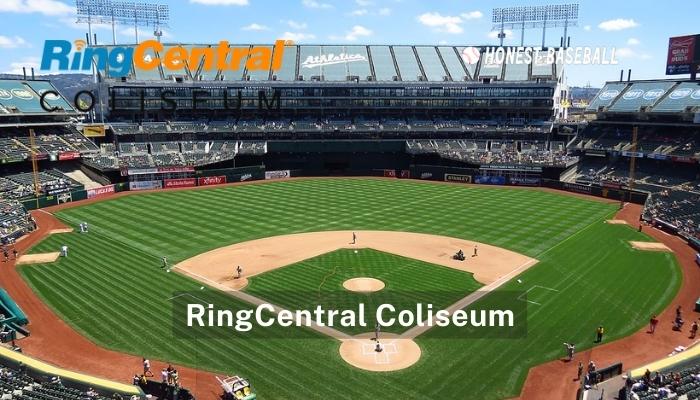
- Situated in: Oakland, Calif
- Host Team: Oakland Athletics
- First Opened: 17th April 1968
- The capacity of Spectators: 46, 847
- The Player Who Got the First Home Run: Boog Powell
- The Player Who Leads the Home Run for All-Time: Mark McGwire (166)
RingCentral Coliseum, formally Oakland, Coliseum, is an MLB stadium where the Oakland Athletics has been playing since 1968 after relocating from Kansas City. The Oakland Athletics shared the stadium with NFL’s Raiders till 1982 since they left.
The Oakland Athletics negotiated a deal once more in 1995 to bring the Oakland Raiders to Oakland Coliseum. The transaction boosted the capacity of the Oakland Coliseum, a multi-use facility.
By the way, the Oakland Raiders relocated to Las Vegas in 2020 after leaving Oakland Coliseum once more. Due to its multifunctional nature, the Oakland Coliseums has remained one of the worst stadiums since the Raiders relocated.
The Oakland Coliseum officially said goodbye to Major League Baseball on September 26, 2024, after hosting the Oakland Athletics for 57 years. In their final game at the stadium, the A’s pulled off a 3–2 win against the Texas Rangers, with nearly 47,000 fans packing the stands for one last emotional night.
This move had been in the works for a while, as the team had struggled for years to secure a new stadium in Oakland. In 2023, the Athletics confirmed their relocation to Las Vegas, where they plan to build a state-of-the-art ballpark on the site of the former Tropicana Las Vegas hotel and casino. MLB owners unanimously approved the move in November 2023, making it official.
While the new Vegas stadium won’t be ready until 2028, the A’s need a temporary home. They’ll play at Sutter Health Park in Sacramento from 2025 to 2027, with the option to extend for 2028 if needed.
For Oakland sports fans, this marks the end of an era—the city has now lost all of its major pro teams, including the Raiders (NFL) and Warriors (NBA). It’s another example of how teams chase bigger markets and modern stadiums, even if it means leaving behind a loyal fanbase.
6. Kauffman Stadium – 1973

- Situated in: Kansas City, Missouri
- Host Team: Kansas City Royals
- First Opened: 10th April 1973
- The capacity of Spectators: 37,903
- The Player Who Got the First Home Run: John Mayberry
- The Player Who Leads the Home Run for All-Time: George Brett (136)
In 1973, the Kauffman stadium was constructed as a baseball-only venue, even though the time was when multi-purpose stadiums were being erected. Royals Stadium was the previous name of the facility. The installation of the stadium’s Crown Vision video board is among the major modifications.
One of the major stadium remodeling projects for Major League Baseball took place from 2007 to 2009. Additionally, the seating capacity increased to 37,903 with the most recent remodeling.
While building such massive structures at the time, it was also about creating a water cascade.
Together with Arrow Head Stadium, the Kansas City Stadium was constructed. It is the Kansas City Chiefs’ home stadium. However, the Kauffman Stadium is the 6th oldest MLB stadium in the USA still in use.
7. Rogers Centre – 1989

- Situated in: Toronto
- Host Team: Toronto Blue Jays
- First Opened: 3rd June 1989
- The capacity of Spectators: 49,282
- The Player Who Got the First Home Run: Fred McGriff
- The Player Who Leads the Home Run for All-Time: Carlos Delgado (175)
At first, the Center was called SkyDome. It is the first ballpark with an impulsion retractable roof. The rooftop is opened and closed by the use of an elaborate rail layout. As a result, the rooftop of the Rogers Centre may be covered to provide protection from rain or excessive sunlight.
The stadium has a hotel with 70 rooms that offer views of the famous CN Tower. When the stadium’s rooftop is opened, this takes place.
The stadium’s single-season record for attendance is about 4 million, set in 1990.
Let’s see the opening of Rogers Centre’s roof opening:
8. Guaranteed Rate Field – 1991
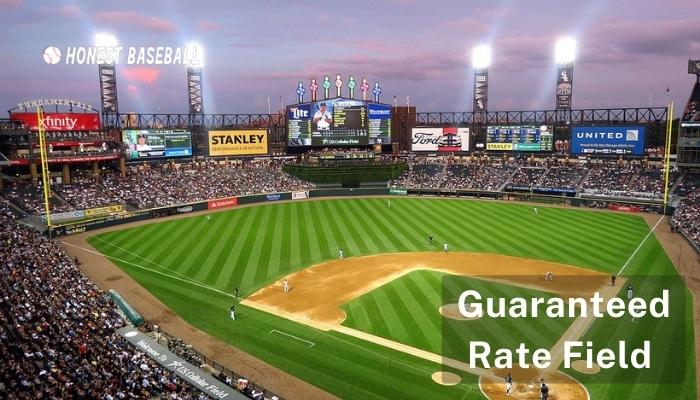
- Situated in: Chicago
- Host Team: Chicago White Sox
- First Opened: 18th April 1991
- The capacity of Spectators: 40,615
- The Player Who Got the First Home Run: Cecil Fielder
- The Player Who Leads the Home Run for All-Time: Frank Thomas (263)
The successor to the original Comiskey Park is the Guaranteed Rate Field. From 1910 through 1990, this served as the Chicago White Sox’s home field. It was the final baseball stadium built before the retro-classic style became popular in the design world.
From 1991 to 2003 and from 2003 to 2016, the Guaranteed Rate Field was called Comiskey Park and U.S. Cellular Field, respectively. Fans used to be critical of the authority because it was one of the earlier models. The stadium had a complete refurbishment as a consequence in 2001.
Despite undergoing a complete makeover, the Guaranteed Field’s architecture is outdated compared to the relatively new Camden Yards. The Camden Yards design actually set an advanced design revolution for the next 25 years, so nothing was done by others designed before it.
9. Oriole Park at Camden Yards – 1992
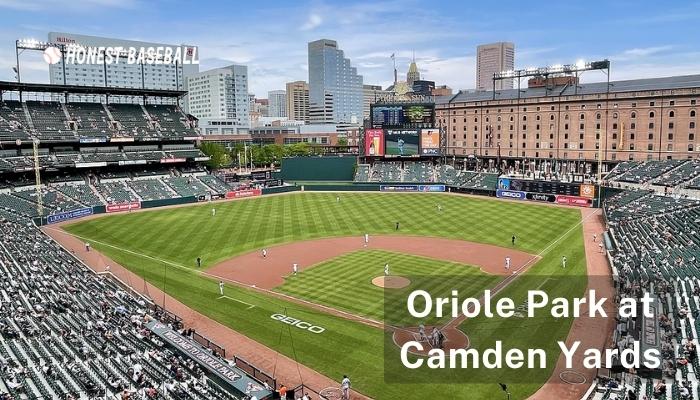
- Situated in: Baltimore
- Host Team: Baltimore Orioles
- First Opened: 6th April 1992
- The capacity of Spectators: 45,971
- The Player Who Got the First Home Run: Paul Sorrento
- The Player Who Leads the Home Run for All-Time: Adam Jones (146)
The Oriole Park at Camden Yards established and spurred a new design revolution with its retro-classic ballpark layout. In the early 2000s and the 1990s, the trend first emerged.
The Camden Yards are only a short walk from the Baltimore inner harbor. This stadium set itself apart from other stadiums built in the post-retro-classic era because of its distinctive wall architecture, a wide variety of food options, and spacious concourses.
The Baltimore Orioles play their home games in the stadium to the right of Baltimore.
10. Progressive Field – 1994
- Situated in: Cleveland
- Host Team: Cleveland Indians
- First Opened: 2nd April 1994
- The capacity of Spectators: 35,000
- The Player Who Got the First Home Run: Eric Anthony
- The Player Who Leads the Home Run for All-Time: Jim Thome (190)
Cleveland Indians’ home field is Progressive Field. After the 1993 campaign, they relocated to this field. Jacobs Field was the initial name of the stadium. The biggest video board at Progressive Field, which is 221 feet wide and 59 feet tall, the toothbrush-shaped light towers, and the 19-foot-high wall in left field are among its notable features.
On the other side, Progressive Field had a unique record of selling out 455 straight home games from the 1995 to 2001 season.
By the way, the Cleveland Indians relocated to Progressive Field after many years of playing in the Municipal stadium. They also turned it into one of the most well-known multifunctional stadiums (football stadiums).
When the Indians arrived, another miracle occurred. They won two of the first three World Series in the ballpark despite never having won a series before.
Additionally, the Indians contributed a fantastic restoration to the park’s top right deck, transforming it into a great American ball park. The rest of the field, meanwhile, is unchanged from 1994.
11. Coors Field – 1995
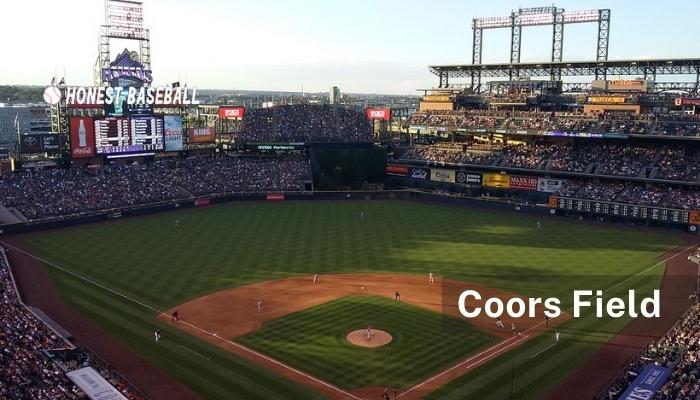
- Situated in: Denver, Colorado
- Host Team: Colorado Rockies
- First Opened: 26th April 1995
- The capacity of Spectators: 46,897
- The Player Who Got the First Home Run: Rico Brogna
- The Player Who Leads the Home Run for All-Time: Todd Helton (227)
The Coors Field is the home ground of the Colorado Rockies. It was first opened on the 26th of April in 1995. Before going to Coors Field, the Rockies played their first two seasons in Mile High Stadium.
4,483,350 fans were the most visitors ever recorded there during their first campaign in the Mile High school Stadium.
Coors Field is a masterpiece of architectural design, by the way. Because it installed a subsurface heating system for the first time in a baseball stadium in the USA. A significant archaeological event also occurred during construction. While excavating the dirt, many fossilized, whole dinosaurs were discovered.
However, Coors Field’s walls are the deepest of all MLB stadiums due to the environmental conditions. High elevations and thin air characterize Denver. Even the thickest barriers occasionally can’t stop the ball from leaving the park.
By the way, the Colorado Rockies are off to a tremendous start. They won their first game at Coors Field thanks to a walk-off home run by Dante Bichette. The game was in its 14th inning (!). According to what I said about the air at Coors Field, batters prefer to hit there because of the favorable environmental conditions.
12. Tropicana Field – 1998
- Situated in: St. Petersburg, Florida
- Host Team: Tampa Bay Rays
- First Opened: 31st March 1998
- The capacity of Spectators: 42,735
- The Player Who Got the First Home Run: Luis Gonzalez
- The Player Who Leads the Home Run for All-Time: Evan Longoria (129)
The Tropicana Field was mainly opened as a baseball stadium in 1990. But, it came to MLB far later, in 1998. It is the only MLV stadium that has a non-retractable dome. By the way, because of 4 catwalks hanging from the ceiling, it becomes one of the worst due to batted balls stuck there often.
13. Chase Field – 1998
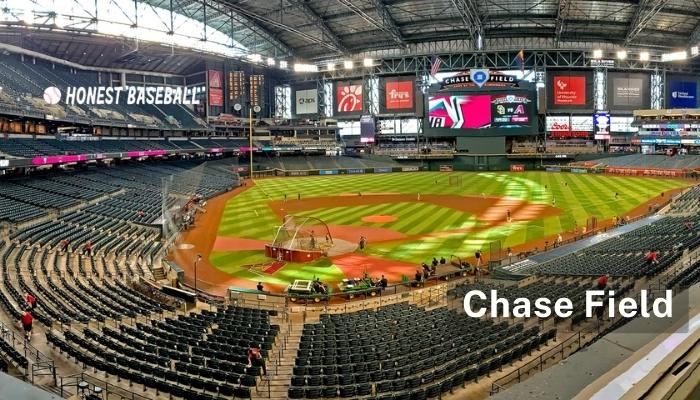
- Situated in: Phoenix, Arizona
- Host Team: Arizona Diamondback
- First Opened: 31st March 1998
- The capacity of Spectators: 48,405
- The Player Who Got the First Home Run: Vinny Castilla
- The Player Who Leads the Home Run for All-Time: Paul Goldschmidt (101)
Chase Field was not the first baseball stadium to have a retractable roof or a dome. But this is the first time they have both together. In MLB stadium history, it was the catalyst for the second wave of retractable roofs.
A swimming pool is located next to the right field fence at one of the prettiest and most fan-friendly ballparks. 2001 World Series games were played at Chase Field.
14. T Mobile Park (1999)
- Situated in: Seattle, Washington, U.S.
- Host Team: Seattle Mariners (MLB)
- First Opened: 15th July 1999
- The capacity of Spectators: 47,929/30,144
- The Player Who Got the First Home Run: Russ Davis
- The Player Who Leads the Home Run for All-Time: Kyle Seager (94)
The T-Moble Park is first opened in 1998 but built-in 1995. The Seattle Mariners revitalized their baseball interest before moving to the T Mobile park. They Defeated the Yankees in 1995 in a postseason game that gave momentum to funding and constructing the T Mobile park.
15. Minute Maid Park (2000)
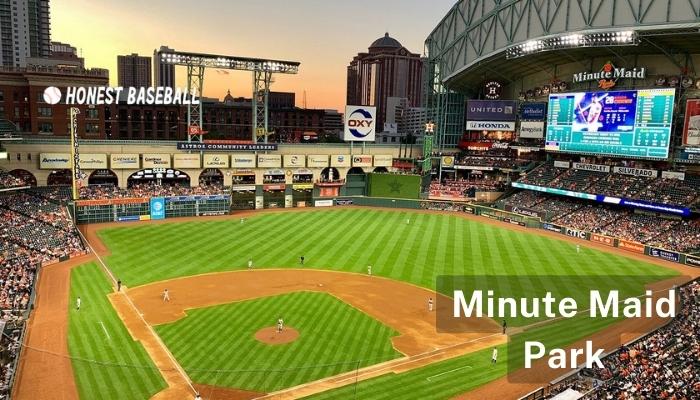
- Situated in: Houston, Texas
- Host Team: Houston Astros
- First Opened: 7th April 2000
- The capacity of Spectators: 41,168
- The Player Who Got the First Home Run: Scott Rolen
- The Player Who Leads the Home Run for All-Time: Lance Berkman (157)
There are numerous other names for Minute Maid Park, including The Ballpark, at Union Station, Astros Field, and Enron Field. In 1965, the Houston Astros had it constructed. However, it was constructed to replace the Astrodome as the first domed sports stadium in the globe.
After 30 years of construction, the Minute Maid firm buys it and changed its name. By the way, it continues to be the Houston Astros’ home field.
16. Oracle Park (2000)
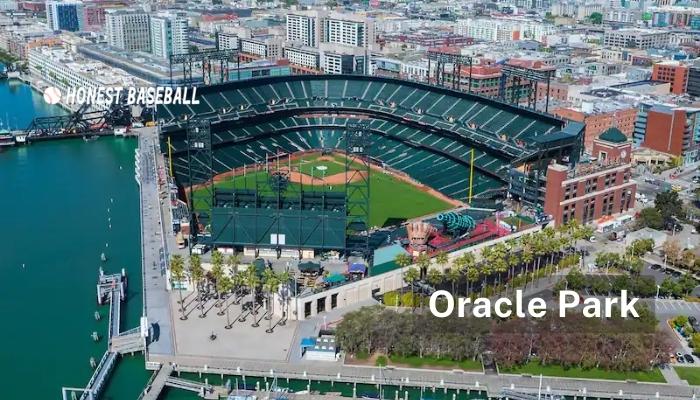
- Situated in: San Francisco, California
- Host Team: San Francisco Giants
- First Opened: 11th April 2000
- The capacity of Spectators: 41,915
- The Player Who Got the First Home Run: Kevin Elster
- The Player Who Leads the Home Run for All-Time: Barry Bonds (160)
One of the top MLB venues in the USA for watching. Its location next to San Francisco Bay provides an incredible view of the ocean. Since 2000, it has served as the San Francisco Giants‘s home field.
For the San Francisco Giants, this stadium takes the place of the previous Candlestick Park. Fans frequently use boats or kayaks to go to McCovey Cove, which is located beyond the right-field wall of the stadium.
The Giants icon Willies McCovey May is honored with the nickname McCovey Cove.
17. Comerica Park (2000)
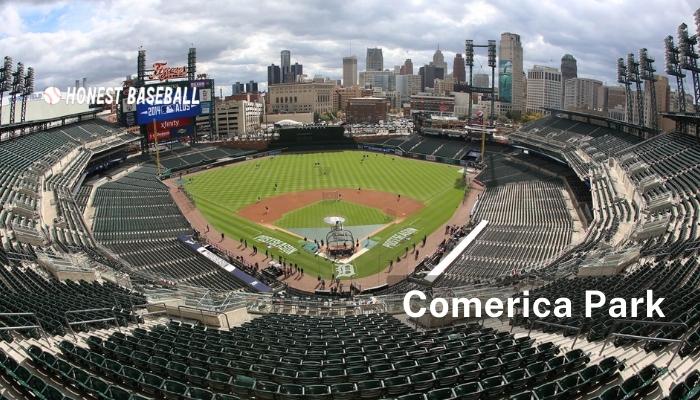
- Situated in: Detroit, Michigan
- Host Team: Detroit Tigers
- First Opened: 11th April 2000
- The capacity of Spectators: 41,083
- The Player Who Got the First Home Run: Juan Gonzalez
- The Player Who Leads the Home Run for All-Time: Miguel Cabrera (184)
Following its departure from the illustrious Tiger Stadium from 1912 to 1999, Comerica Park became a fixture for the franchise. In the meanwhile, it develops into a pitcher’s paradise. A fountain is located behind home plate, and the outfield is quite expensive.
Bobby Higginson, an outfielder with the Detroit Tigers, gave the venue the moniker “Comerica National Park.” A huge scoreboard and a 50-foot Ferris wheel are also present.
18. American Family Field (2001)
- Situated in: Milwaukee, Wisconsin
- Host Team: Milwaukee Brewers
- First Opened: 6th April 2001
- The capacity of Spectators: 41,900
- The Player Who Got the First Home Run: Michael Tucker
- The Player Who Leads the Home Run for All-Time: Ryan Braun (173)
The American Family Field is a fan-shaped retractable roof ballpark. The rooftop closes from the foul lines toward the center field. It takes as fast as 10 minutes to close the rooftop.
The American Family Park has been the home ground of the Milwaukee Brewers since 2001.
19. PNC Park (2001)

- Situated in: Pittsburgh, Pennsylvania
- Host Team: Pittsburgh Pirates
- First Opened: 9th April 2001
- The capacity of Spectators: 38,747
- The Player Who Got the First Home Run: Sean Casey
- The Player Who Leads the Home Run for All-Time: Andrew McCutchen (92)
The Pittsburgh Pirates played their home games at Three Rivers Stadium before moving to PNC Park. The PNC Stadium is well-known for its spectacular views of downtown Pittsburgh. Another view from the stadium is of Roberto Clemente Bridge.
It’s been in use since 2001 and is currently used as the Pittsburgh Pirates’ home ground.
20. Great American Ball Park (2003)
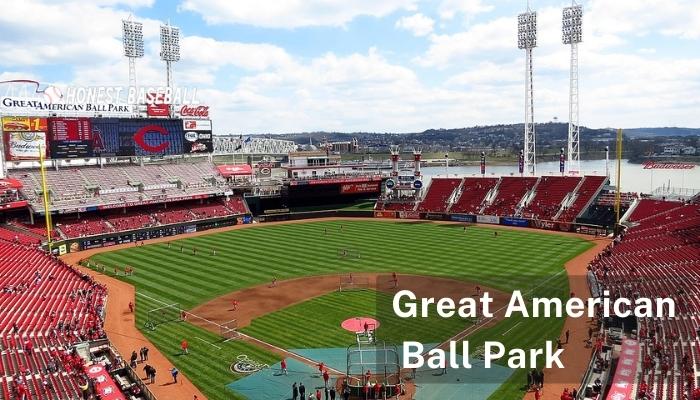
- Situated in: Cincinnati, Ohio
- Host Team: Cincinnati Reds
- First Opened: 31st March 2003
- The capacity of Spectators: 43,500
- The Player Who Got the First Home Run: Reggie Sanders
- The Player Who Leads the Home Run for All-Time: Joey Votto (182)
The Great American Ball Park is situated on the bank of the Ohio River. It is also known as the Riverfront Stadium which has been used as the home ground of the Cincinnati Reds since 2003.
A firework power stack is designed to the right-center field, which reminds the steamboat of the Ohio River. This is about the 19th and early 20th centuries.
21. Petco Park (8th April 2004)
- Situated in: San Diego, California
- Host Team: San Diego Padres
- First Opened: 8th April 2004
- The capacity of Spectators: 40,209
- The Player Who Got the First Home Run: Marquis Grissom
- The Player Who Leads the Home Run for All-Time: Adrian Gonzalez (65)
The San Diego Padres moved into their new stadium, Petco Park, in 2004. Prior to it, they played until the 2003 MLB season in Qualcomm Stadium. The stadium is a special baseball-only building.
The most important piece of Petco Park’s history is a 1909 Metal Supply Co. structure. In 1978, the structure was designated as a national historical monument. Before the stadium and the building worked together, the municipal council made the proclamation.
22. Citizens Bank Park (2004)
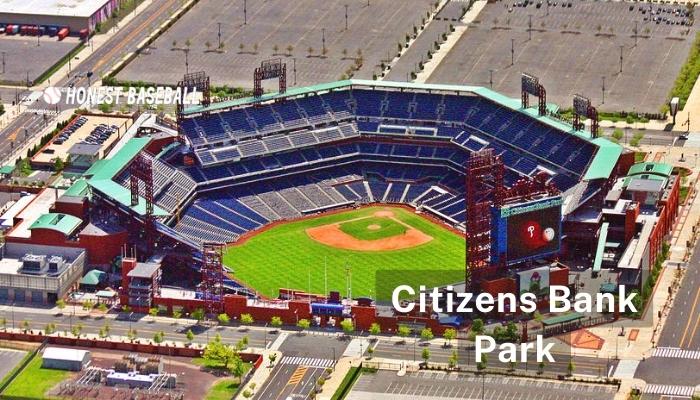
- Situated in: Philadelphia, Pennsylvania
- Host Team: Philadelphia Phillies
- First Opened: 12th April 2004
- The capacity of Spectators: 42,792
- The Player Who Got the First Home Run: Bobby Abreu
- The Player Who Leads the Home Run for All-Time: Ryan Howard (198)
The National League’s largest video screen is located at Citizens Bank Park. The ballpark, which serves as the Philadelphia Phillies’ home field, was erected in 2004. The Philadelphia Phillies relocated to their new home in South Philadelphia for the 2003 postseason, leaving their previous home at Veterans Stadium.
Bank of Citizens A natural grass pitch may be seen at Bank Park, a stadium. Additionally, it is a baseball-only venue.
23. Busch Stadium (2006)
- Situated in: St. Louis, Missouri
- Host Team: St. Louis Cardinals
- First Opened: 10th April 2006
- The capacity of Spectators: 45,494
- The Player Who Got the First Home Run: Bill Hall
- The Player Who Leads the Home Run for All-Time: Albert Pujols (112)
Since 2006, the Busch Stadium has served as the St. Louis Cardinal’s home field. After playing 40 seasons in their previous stadiums, the Cardinals have moved to their third home field.
More vistas and an open architecture characterize the new Busch Stadium. As a result, the Gateway of Arch and the Cardinal’s sky is clearly seen.
The Busch Stadium’s significance comes from the fact that the Cardinals won the initial season there.
24. Nationals Park (2008)

- Situated in: Washington, D.C.
- Host Team: Washington Nationals
- First Opened: 30th March 2008
- The capacity of Spectators: 41,339
- The Player Who Got the First Home Run: Chipper Jones
- The Player Who Leads the Home Run for All-Time: Ryan Zimmerman (116)
The Nationals Park became the home ground of the Washington Nationals home ground in 2008. Before returning to the specific home ground, the Washington Nationals played three seasons from 2005 to 2007 in the Washington Senators’ former home ground at RFK Stadium.
The Nationals Park is situated about one mile away from Washington DC to the south. The Nats also won their first game on the field.
25. Citi Field (2009)
- Situated in: Flushing, Queens, New York City
- Host Team: New York Mets
- First Opened: 13th April 2009
- The capacity of Spectators: 44,466
- The Player Who Got the First Home Run: Jody Gerut
- The Player Who Leads the Home Run for All-Time: Lucas Duda (71)
Popularity-wise, Citi Field Stadium ranks up there with the best of them. Over 41,000 fans may see a game here when the New York Mets play at home. In 2009, after spending $850 million on construction, the stadium opened to the public. Placed in New York’s Queens borough.
There is a retractable roof on the stadium, so games may be played in all kinds of weather. Modern lighting technology also means that evening games can be held there. The stadium also features several dining and drinking establishments where visitors may unwind and mingle before and after games.
One of the most cutting-edge venues in the world, Citi Field Stadium is home to state-of-the-art amenities. It has numerous places to plug in your electronic devices and access Wi-Fi all across the stadium. There is a dedicated app for the stadium that lets you buy concessions without leaving your seat.
There are several subway stops in close proximity to the stadium, making it easy to reach via public transit. As for parking, there are a number of lots in the area, though they tend to be pricey on game days.
26. Yankee Stadium (2009)
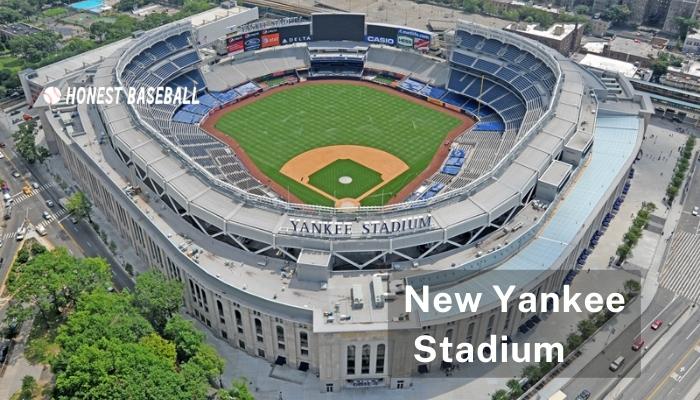
- Situated in: The Bronx, New York
- Host Team: New York Yankees
- First Opened: 16th April 2009
- The capacity of Spectators: 46,537
- The Player Who Got the First Home Run: Jorge Posada
- The Player Who Leads the Home Run for All-Time: Mark Teixeira (113)
The New York Yankees play their home games in the brand-new Yankee Stadium. It is located in New York City’s Bronx. New York City FC of Major League Soccer plays at this multi-use facility.
In 2009, the old Yankee Stadium was replaced with the new one. The third-largest MLB stadium currently in operation is this one. The appearance of the old Yankee Stadium is still present. It is due to its distinctive qualities, including its limestone exterior and white frieze rooflines.
The New Yankee Stadium has a 314-foot-long porch and a field that is the same size.
Honorable Mention: Old Yankee Stadium
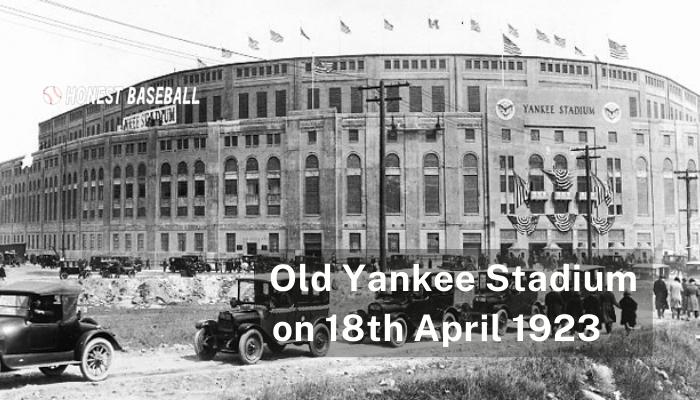
The old Yankee Stadium currently is not in use. But, it comes to our list as an honorable mention because of its history and legends. The Old Yankee Stadium was built from 1922 to 1923.
It was first opened on 18th April 1923. The New York Yankees won their first game against Babe Ruth’s former team Boston Red Sox with a score of 4-1. Though the primary capacity f the stadium was 58,000, the first-game attendance record was recorded at 74,217.
By the way, the popularity of Yankee Stadium had gone so high that 80,000 visitors were a common phenomenon in each game.
Latest MLB Stadiums
Target Field (2010)
When the Minnesota Twins’ new stadium, Target Field, debuted in 2010, it was acclaimed as one of baseball’s finest venues. It can seat over 39,000 people and offers amazing views of Minneapolis. Popular park fare includes authentic Minnesota specialties like Juicy Lucy burgers and hotdish.
The Metrodome was demolished in 2009 to make way for a new ballpark for the Minnesota Twins. Construction of Target Field, home of the Minnesota Twins, began in October 2009 and was completed on April 12, 2010. The Twins and the Cardinals played the first-ever game at Target Field in a preseason exhibition. On April 14, 2010, the inaugural regular season game was played against the Boston Red Sox.
Populous (formerly HOK Sport) was responsible for the design of Target Field, which boasts a brick exterior with limestone detailing. The ballpark has a variety of interesting features, such as a view of downtown Minneapolis from any seat and a garden in the outfield wall to the right.
The ballpark’s design has received a lot of attention.
loanDepot park (2012)
loanDepot Park is a stunning venue for San Diego Padres home games. This park is home to a grass field that can accommodate 42,445 spectators. The infield is located in the southwest, while the outfield is in the northeast, making for an unusually shaped ballpark. The “greenest” in the Majors, this park has received several accolades.
The ballpark’s exceptional placement in downtown San Diego makes it easy to get to from anywhere. Those who would rather not drive have a lot of options for getting around and leaving their cars. If you’re worried about getting hungry or thirsty before or after the game, don’t be; there are lots of options close to the ballpark.
You must go see a game at loanDepot Park if you’re a baseball fan.
Truist Park (2017)
The Atlanta Braves play their home games at one of MLB’s newest venues, Truist Park. The stadium opened in 2017 in the Georgia city of Cumberland. The stadium has a retractable roof and seats 41,149 spectators. Modern lighting and sound equipment have been installed in the stadium as well.
Since its inception, Truist Park has served as more than just the Atlanta Braves’ home field. These include college football games, auto racing events, and concerts by singers like Jason Aldean, Kenny Chesney, Ed Sheeran, Maroon 5, Luke Bryan, and Garth Brooks.
Globe Life Park (2020)
In 2020, the Texas Rangers called Globe Life Park their new ballpark. The ballpark in Arlington, Texas can hold up to 48,114 fans. It’s a huge baseball stadium, even by American standards.
The Arlington Ballpark was the inspiration for what is now known as Globe Life Park. It first welcomed fans in 1994 and housed the Rangers until 2019 when they relocated to Globe Life Field.
The ballpark is conveniently located just south of Arlington’s downtown and can be reached by automobile or public transit. There are also plenty of dining and drinking options within easy walking distance.
Depending on the weather, the Globe Life Park’s roof can be opened or closed.
Frequently Asked Questions
What is the smallest MLB stadium?
The Cleveland Guardians’ home ground, Progressive Field is currently the smallest stadium in terms of capacity. Initially, it was designed for 42,865 people. But after a renovation, the capacity stands at 34,830.
What is the Biggest MLB stadium?
The Oakland Coliseum is currently the biggest MLB stadium in terms of capacity. The stadium’s capacity is 56,782 (expandable), which is currently the most among the MLB stadiums in use.
Here is a list of the 24 biggest MLB Stadiums to check for information.
Final Note
Many other legendary stadiums might be on the list of oldest MLB stadiums. But, somehow they are not in use today. However, this list is made from the oldest to the newest based on their current use state.
You May Also Like
Do MLB Umpires Pay For Travel?
How Many Rounds Are In The MLB
10 Best Team Record In MLB History

Hello everyone. My name is Jason Butler, and I live in California, America. I was a professional AAA Minor League Baseball player. I lost my chance of playing MLB for injury issues, but I did not lose my love for baseball. I attended the coaching training program and am now working as a coach in a small school in San Diego.
I always love to share my experience and knowledge if that can help you. Play baseball, and stay fit.
